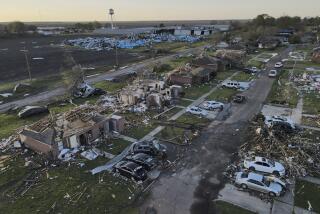Not so easy
The blight and disrepair that fester in New Orleans two years after Hurricane Katrina slammed and swamped the city are a testament not just to the scale of the disaster but to the failures of government at all levels.
Statistics provide a sketch of a community that’s making progress, albeit with a long way to go. In Orleans Parish, where about 437,000 people lived before hurricanes Katrina and Rita, about 265,000 reside now -- some 100,000 more than the post-storm low. The numbers of cargo shipments at the port of New Orleans and passengers at the local airport are only 10% lower than they were pre-Katrina. However, aid programs to rebuild schools, hospitals, sewer systems and homes have sputtered, delayed by red tape and excruciatingly slow planning. Mayor C. Ray Nagin and other city leaders have seemed paralyzed by the enormity of the task, unable to make tough decisions about where and what to rebuild.
Early this year, the city finally brought in a distinguished urban planner to shepherd its recovery efforts: Edward Blakely, a former UC Berkeley department head whose disaster-recovery resume includes helping Oakland rebound from the 1989 Loma Prieta earthquake and 1991 fires. Blakely wants to concentrate the city’s rebuilding efforts on 17 high-priority areas. That sort of smaller-but-smarter focus echoes the earlier recovery plans that city leaders abandoned in the face of opposition from local property owners. Now those leaders need to help Blakely turn what’s on paper into actual, working redevelopment projects.
The task of rebuilding is so great that it would take years to finish even under ideal circumstances. But the seeming lack of urgency in New Orleans poses a risk of its own: that residents and policymakers will tire of the slow recovery and give up on the city. To pick up the pace, Congress should retool the Stafford Act, the federal law that governs emergency aid, to better handle catastrophic events. The act’s paperwork requirements are irrational for cities making emergency repairs on a grand scale. And many of the requirements aim to prevent dollars from being misused rather than making sure that infrastructure problems are solved efficiently. As a result, Louisiana has been able to spend only a quarter of the money Washington has committed to build schools, hospitals and other infrastructure.
Congress is poised to take another important step to help southeastern Louisiana. A pending water-resources protection bill calls for the closure of the Mississippi River Gulf Outlet, a shipping channel that undermined critical levees by destroying wetlands. Lawmakers should continue to look beyond levee reconstruction and focus on the more expensive task of restoring the coast’s natural defenses against flooding.
Federal taxpayers have already committed nearly $60 billion to Louisiana in flood-insurance payments, disaster relief and rebuilding funds. It would compound the tragedy of Katrina to leave the job half-finished or to bury the region’s will to rebuild under a mountain of red tape.
More to Read
A cure for the common opinion
Get thought-provoking perspectives with our weekly newsletter.
You may occasionally receive promotional content from the Los Angeles Times.










